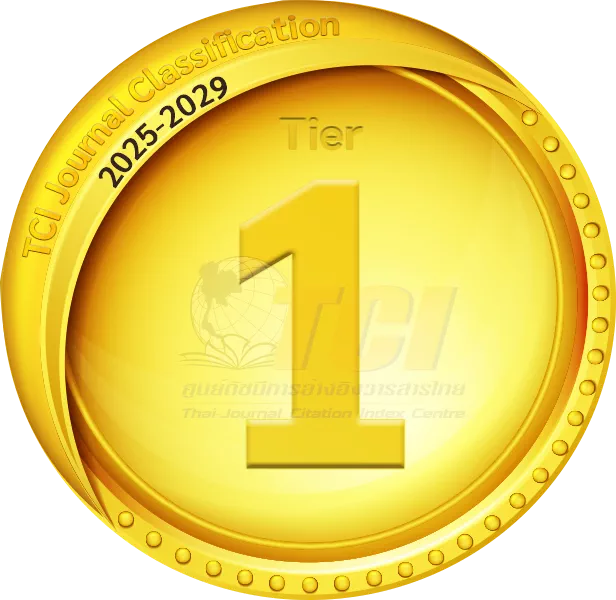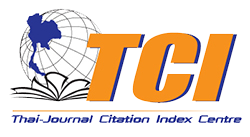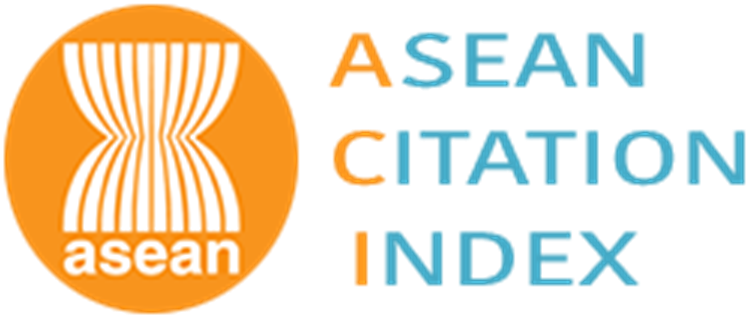Long-Term Monitoring and Finite Element Analysis of The Pasana Chedi Wat Ratchapradit Sathimahasimaram Ratchaworawihan based on Terrestrial Laser Scanning Data
Abstract
บทความนี้เสนอการประยุกต์ใช้ข้อมูลการสแกนวัตถุ 3 มิติ เพื่อการติดตามสภาพโครงสร้างระยะยาว รวมถึงการประเมินเสถียรภาพของโครงสร้างปาสาณเจดีย์วัดราชประดิษฐสถิตมหาสีมาราม ราชวรวิหาร เขตพระนคร จังหวัดกรุงเทพมหานครด้วยวิธีการไฟไนต์เอลิเมนต์ งานวิจัยนี้ดำเนินการเก็บข้อมูลดิจิทัลในรูปแบบกลุ่มจุดสามมิติใน 3 ช่วงเวลา ตั้งแต่ พ.ศ. 2563–2565 เพื่อติดตามและตรวจสอบการเปลี่ยนแปลงสภาพเจดีย์วัดราชประดิษฐ ฯ ในระยะยาว ซึ่งข้อมูลที่ได้สามารถนำไปวิเคราะห์ขนาดมิติในสภาวะปัจจุบัน และประเมินมุมเอียงของปาสาณเจดีย์ได้ รวมทั้งมีการนำเสนอวิธีการประยุกต์ใช้ข้อมูลกลุ่มจุดสำหรับการสร้างแบบจำลองสามมิติเพื่อใช้ในการประเมินเสถียรภาพของปาสาณเจดีย์ด้วยโปรแกรม Abaqus โดยผลการวิเคราะห์ข้อมูลกลุ่มจุดและมุมเอียงของเจดีย์ไม่พบการเปลี่ยนแปลงมุมเอียงอย่างมีนัยสำคัญในช่วงระยะเวลาการศึกษา จากผลการกระจายหน่วยแรงของโครงสร้างภายใต้น้ำหนักเจดีย์พบว่า บริเวณที่เกิดความเค้นอัดและความเค้นดึงสูงสุดมีค่าเท่ากับ 0.237 เมกะพาสคัลที่บริเวณฐานเขียง และ 0.033 เมกะพาสคัลที่บริเวณพื้นภายในปาสาณเจดีย์ ตามลำดับนอกจากนี้มีการศึกษาการเปลี่ยนสมบัติเชิงกลของวัสดุที่มีผลต่อการกระจายหน่วยแรงค่าการเคลื่อนตัวสูงสุด และคาบการสั่นอิสระ ที่อาจส่งผลกระทบต่อเสถียรภาพของโครงสร้างเจดีย์ สุดท้ายนี้กระบวนการและผลการศึกษาจะเป็นประโยชน์ต่องานอนุรักษ์วัดราชประดิษฐ ฯ ได้ในอนาคต
This article presents the applications of three-dimensional laser scanning data for long-term monitoring and stability assessment using the finite element method of the Pasana Chedi, Wat Ratchapradit Sathimahasimaram Ratchaworawihan, Phra Nakhon district, Bangkok. This research collected digital data in the form of 3D point clouds over three sessions, from the year 2020 to 2022, to monitor and investigate changes in the condition of Wat Ratchapradit in the long term. The obtained data can be used to analyze the current dimensions and assess the leaning angles of the Pasana Chedi. The methodology is presented for applying point cloud data to create a three-dimensional model for assessing the stability of the Pasana Chedi using Abaqus software. The analysis of point cloud data and the leaning angles of the Chedi did not reveal any significant changes during the study sessions. According to the stress distribution result of a structure caused by the self-weight of the Chedi, the maximum compressive stress and te sile stress are 0.237 MPa at Than Keang and 0.033 MPa at the floor inside the Chedi, respectively. In addition, a study was conducted on the changes in the mechanical properties of materials that could affect the stress distribution, maximum displacement, and natural period, which might impact the stability of the Chedi. Finally, the methodologyand results will benefit the future preservation of Wat Ratchapradit.
Keywords
[1] Department of Religious Affairs, Ministry of Culture, Phra A-ram Luang vol. 1., 2nd ed. Bangkok, Thailand: The Agricultural cooperative printing demonstrations of Thai Ltd., 2021, pp. 70–75 (in Thai).
[2] W. Osatharom, “A review of Ratchapradit Pipittatsana,” Journal of Fine Arts, vol. 4, no. 1, pp. 364–378, 2013 (in Thai).
[3] S. Saisingha, “Stupas in Thailand Vol. 2,” Silpakorn University Research, Innovation and Creativity Adminsration Office, Bangkok, 2015 (in Thai).
[4] S. Leelataviwat, W. Tangchirapat, C. Athisakul, and R. Sahamitmongkol, “Development of engineering database for assessment and structutal health monitoring of thailand historic sturcture,” Thailand Research Fund, Bangkok, 2019 (in Thai).
[5] B. Bhadrakom, “Integrated measures for geometric documentation and structural performance assessment of ancient heritage monuments: A case study of Phra Chedi Wat Yai Chai Mongkol,” Ph.D. dissertation, Department of Civil Engineering, Faculty of Engineering, Thammasat University, Bangkok, 2018 (in Thai).
[6] C. Athisakul, S. Leelataviwat, P. Mahasuwanchai, S. Thonket, C. Binzaits, S. Nithipatikhom, and S. Kaewmakoon, “Application of 3D laser scanning technology for assessment and structural health monitoring of Thai Chedi: A case study of Wat Rajabophit,” National Research Council of Thailand, Bangkok, 2020 (in Thai).
[7] S. Thonket, P. Mahasuwanchai, N. Wonganan, C. Binzaits, S. Nithipatikhom, S. Kaewmakoon, C. Athisakul, W. Tangchirapat, and S. Leelataviwat, “3D Laser scanning data and masonrymaterials properties of Wat Ratchabophit Sathitmahasimaram Ratchaworawihan,” in Proceedings the 25th National Convention on Civil Engineering, Chonburi, 2020, pp. 1–8 (in Thai).
[8] C. Athisakul, S. Leelataviwat, W. Tangchirapat, and R. Sahamitmongkol, “Development of digital database for engineering assessment and structural health monitoring of Thai Pagodas in Ayutthaya historical park,” PMU-B, Bangkok, 2019 (in Thai).
[9] S. Kaewmakoon, P. Mahasuwanchai, C. Athisakul, and S. Leelataviwat, “3D laser scanning data and finite element method for seismic analysis of Thai Bell-Shaped Pagoda: A case study of Wat Si Phichit Kirati Kanlayaram,” in Proceedings the 26th National Convention on Civil Engineering, Online conference, 2021, pp. 1–8 (in Thai).
[10] S. Suksila, P. Mahasuwanchai, C. Athisakul, and S. Leelataviwat, “Terrestrial laser scanning data and seismic analysis of Wat Mahathat Sukhothai Pagoda,” in Proceedings the 26th National Convention on Civil Engineering, Online conference, pp. 1–8, 2021 (in Thai).
[11] T. Jinanusorn, P. Mahasuwanchai, S. Kaewmakoon, C. Athisakul, and S. Leelataviwat, “3D laser scanning data and finite element analysis of Wat Phra Ram,” in Proceedings the 27th National Convention on Civil Engineering, Phuket, pp. 1–9, 2022 (in Thai).
[12] Faro Laser Scanner Focus3d X330 Manual, FARO Technologies, Lake Mary, FL, 2022.
[13] Scene Classic 2019.2 User Manual, FARO Technologies, Lake Mary, FL, 2019.
[14] Dassault Systèmes Simulia Crop. (2014). Getting Started with Abaqus. Dassault Systèmes Simulia Crop. [Online] Available: http://130.149.89.49:2080/v6.14/books/gsa/ default.htm
[15] Dassault Systèmes Simulia Crop. (2014). Abaqus Theory Guide. Dassault Systèmes Simulia Crop. [Online] Available: http://130.149.89.49:2080/ v6.14/books/stm/default.htm
[16] S. Phansuwan, W. Chatrakul Na Ayuddhaya, and A. Saengnikorn, “Structural system and behavior of masonry historic pagoda,” The Fine Arts Department, Bangkok, 2018 (in Thai).
[17] S. Tohsirimongkol, “Mechanical properties of ancient and substitution bricks for Thai historical structures preservation,” M.S. thesis, Department of Civil Engineering, Faculty of Engineering, King Mongkut's University of Technology Thonburi, Bangkok, 2020 (in Thai).
[18] S. Nithipatikhom, S. Tohsirimongkol, C. Athisakul, W. Tangchirapat, S. Leelataviwat, and P. Mahasuwanchai, “Compressive strength and elastic constant of the ancient and substitution masonry Prisms,” in Proceedings the 26th National Convention on Civil Engineering, Online conference, 2021, pp. 1–8 (in Thai).
[19] C. Phansangud, P. Mahasuwanchai, K. Jintrakham, W. Tangchirapat, C. Athisakul, and S. Leelataviwat, “Mechanical properties of ancient bricks and compressive strength of substitution masonry for ancient building preservation in Chiang Sean,” presented at the 27th National Convention on Civil Engineering, Phuket, Thailand, May. 24–26, 2023 (in Thai).
[20] N. Wonganan, C. Athisakul, P. Mahasuwanchai, W. Tangchirapat, R. Sahamitmongkol, andS. Leelataviwat, “Ancient materials and substitution materials used in Thai Historical Masonry Structure Preservation,” Journal of Renewable Materials, vol. 9, no. 2, pp. 179–204, 2021.
[21] B. Bradrakom, and N. Poovarodom, “Dynamic Investigation of the Main Stupa of Wat Yai Chaimongkol, Ayutthaya,” Thai Science and Technology Journal, vol. 25, no. 4, pp. 1–13, 2017 (in Thai).
DOI: 10.14416/j.kmutnb.2024.09.016
ISSN: 2985-2145





